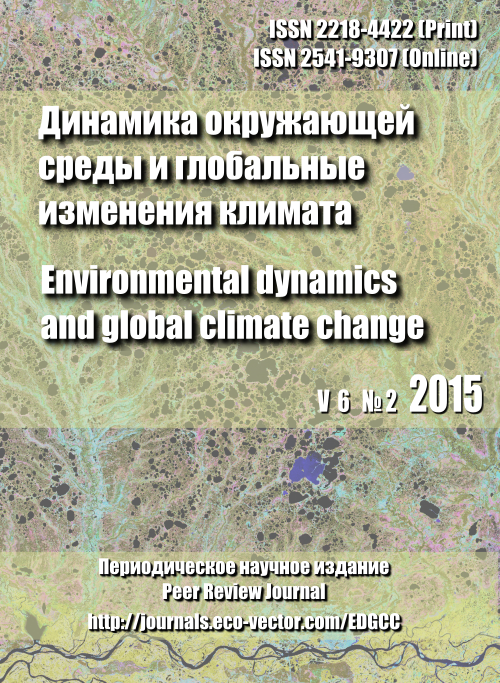Том 6, № 2 (2015)
- Год: 2015
- Выпуск опубликован: 15.12.2015
- Статей: 6
- URL: https://edgccjournal.org/EDGCC/issue/view/378
Статьи
К биологии и экологии Sarcosoma globosum в условиях средней тайги Западной Сибири
Аннотация
В период с 2005 по 2014 год обследована территория левобережной части бассейна Большого Югана в среднем течении на предмет местообитаний Sarcosoma globosum . Обнаружено 29 популяций. Установлено, что этот вид в средней тайге Западной Сибири растет как в дренированных так и в переувлажнённых коренных темнохвойных и производных мелколиственных с темнохвойным подростом мшистых лесах на богатых минеральным питанием почвах. Плодоносит спорадически. Плодовые тела появляются один раз за сезон, в середине - конце мая, и сохраняются до полутора месяцев.
 3-11
3-11


Вселение речного бобра на территорию заповедника "Юганский"
Аннотация
Территория Юганского заповедника в прошлом входила в ареал аборигенного западносибирского речного бобра, который уже более 100 лет в нашем районе не встречается. В результате акклиматизационных мероприятий в 50-х - 70-х гг. ХХ века, прилегающие к заповеднику районы были заселены бобрами европейских популяций. В ходе естественного расселения бобры-переселенцы достигли территории Юганского заповедника и начинают заселять его южную часть. В перечень коридоров расселения входят реки Большой и Малый Юган с их многочисленными притоками различного порядка, берущими начало на охраняемой территории. Обнаружены первые устойчивые поселения бобра в верховьях рек Магромсы и Яккунъях. Вселение бобров на территорию Юганского заповедника произошло в течение одного - двух лет со стороны южной границы на довольно широком по протяженности участке - около 33 км и на глубину от 2 до 6 км.
 12-16
12-16


Эколого-морфологическая характеристика популяции двухцветного кожана в Юганском заповеднике
Аннотация
Двухцветный кожан ( Vespertilio murinus L.) - один из видов фауны рукокрылых Юганского заповедника. Изучение его популяции ведется с 2007 года. Проводятся учеты численности с использованием специальных ультразвуковых детекторов, ведется отлов стационарными паутинными сетями. Пойманные животные метятся и выпускаются на волю. Всего отловлено и помечено 112 особей двухцветного кожана. В популяции преобладают взрослые самки. Численность взрослых самцов незначительна и составляет около 10% от выборки. На одну взрослую самку в среднем приходится 1,3 детеныша. Двухцветный кожан - мигрирующий вид. Первые особи в районе заповедника появляются в середине июня. В выводках до 3 детенышей. Молодые особи становятся самостоятельными в конце июля - начале августа. Практически сразу начинается осенняя миграция. Последние экземпляры улетают в район зимовки до середины сентября.
 17-20
17-20


Предварительные данные по фауне Curculionoidea (Coleoptera) Сургутского района Тюменской области
Аннотация
Фауна насекомых центральной части Западной Сибири изучена совершенно недостаточно, в полной мере это относится и к жукам надсемейства Curculionoidea. Ранее лишь в статье А.А.Легалова и П.С.Ситникова [2000] был указан ряд видов для этой территории. Благодаря любезности А.Б.Рывкина, предоставившего на определение свои сборы за 5 лет работы в Юганском заповеднике, удалось получить, практически, первые сколько-нибудь подробные данные по фауне долгоносиков данного региона. Помимо собственно заповедника и сопредельных территорий, они включают материал, собранный в Сургутском заказнике. Разумеется, этот список крайне не полон, но с чего-то надо начинать. Материал хранится в рабочей коллекции автора (после кончины автора в 2006 г. его рабочая коллекция поступила в Зоологический музей МГУ им. Ломоносова, Москва).
 21-33
21-33


Материалы по фауне пресноводных легочных моллюсков Юганского заповедника и сопредельных территорий
Аннотация
Представлены результаты первого этапа инвентаризации фауны пресноводных легочных моллюсков (Mollusca: Gastropoda: Pulmonata) заповедника «Юганский» и окрестностей, полученные на основе обработки экспедиционных сборов 2012 г. Впервые приведен аннотированный список фауны Pulmonata региона. Предпринят зоогеографический анализ фауны. Констатирован факт низкого видового разнообразия моллюсков, предприняты попытки объяснения этого факта. Проведено сравнение разнообразия фауны Pulmonata Юганского заповедника и других местностей Западной Сибири.
 34-43
34-43


К изучению динамики макрозообентоса рек бассейна реки Большой Юган (Среднее Приобье)
Аннотация
Впервые в период открытой воды (май-сентябрь) изучена динамика таксономического состава, численности и биомассы макрозообентоса рек Большой Юган и Негусъях (Среднее Приобье). Зарегистрированы отличия в динамике качественных и количественных характеристик макрозообентоса на разных створах. Причины изменений состава, численности и биомассы - особенности гидрологического режима рек и жизненных циклов донных беспозвоночных животных, в первую очередь доминантов - личинок комаров семейства Chironomidae и двустворчатых моллюсков надсемейства Pisidioidea.
 44-54
44-54











